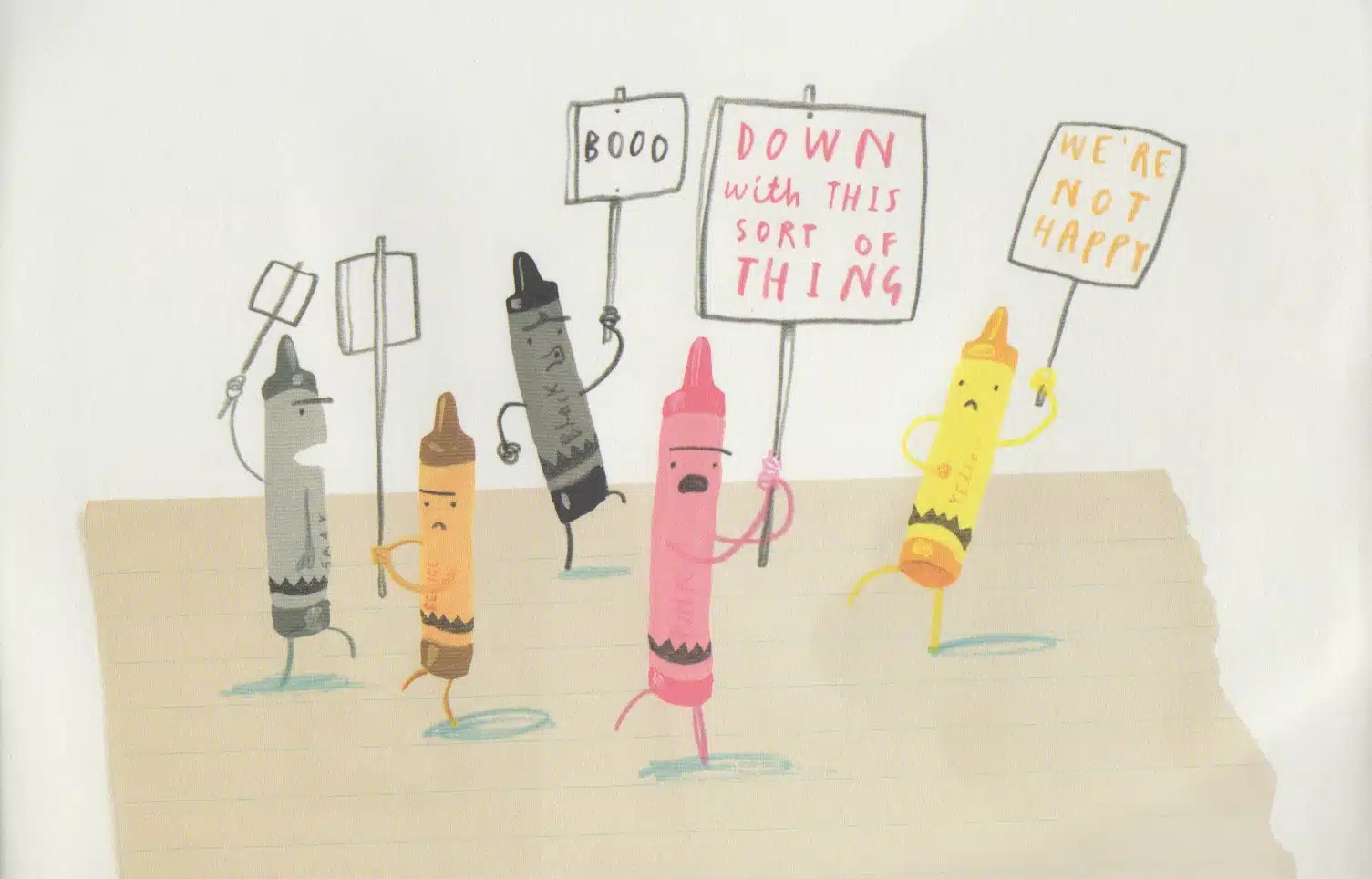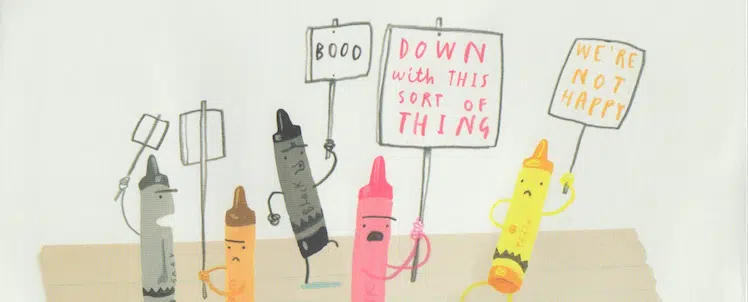Nonprofits: Don't Treat Volunteers and Donors Like Crayons




Inspiration can come from unlikely sources.
A colleague of mine gave me a children’s book as a thank you for speaking at a volunteer training. Before I opened it, she was quick to tell me there was a deeper meaning to the book. A card accompanying the book explained that I should read the book with volunteers and donors in mind.
When I read The Day the Crayons Quit (beautifully written by Drew Daywalt and incredibly illustrated by Oliver Jeffers) with my preschool daughter, and the lessons just leapt off the page.
Please go find this book.
The premise is that a child’s box of crayons is fed up with young Duncan, their owner. He’s used, abused, or completely ignored his individual crayons. They’ve had enough, so they quit and fill his crayon box with notes why they’ve left him.
From the past decade working in development, I can associated a volunteer or donor with each crayon. In fact, I’d like to write similar letters to some the organizations where I volunteer or donate.
This book and its wonderfully simple lessons teach us more about how to guide, use and appreciate our strongest supporters.
“Your overworked friend, Red Crayon”
Red complains that it’s used for every need, from firetrucks to hearts and santas, saying, “You make me work harder than any of your other crayons.” It needs a rest. Unfortunately, the red crayon volunteers or donors in our organizations rarely tell us that they are overworked. We usually notice when it’s too late, when they’re gone. Volunteer time is precious. It’s their most valuable commodity, so steward it well.
“Your very neat friend, Purple Crayon”
Purple complains that it’s used to color outside of the lines. Volunteers and donors, like the purple crayon, tend to stick within their comfort zone. As I think about donors, I think about their giving passions. Do you give them an opportunity to designate their gifts and report back on specific use? Each donor and volunteer has a passion; know it and grow their passion within their area of interest.
“Your beige friend, Beige Crayon”
Do you play favorites, and leave out some volunteers? Beige crayon volunteers are waiting to be used, but often get overlooked by staff who go back to same group of volunteers. The beige crayon feels overlooked because brown gets all of the fun, leaving beige to draw wheat. Volunteers frequently report they feel underutilized; perhaps they leave because we don’t recognize their value!
“Your very tired friend, Grey Crayon”
Grey is tasked with coloring in really big animals like elephants, hippos and whales; it feels overburdened. If this doesn’t sound like a majority of donors, nothing will. Donors often complain about being over-solicited for gifts or, worst of all, being asked before understanding how their previous gift was used. Special event donors must also feel a little grey with the bombardment of asks they encounter attending most silent auction galas.
“Your empty friend, White Crayon”
Similarly to beige, white gets used but is generally unnoticed. These volunteers show up, do their work, but never receive recognition. These donors make consistent (likely unsolicited gifts) without being given the opportunity to learn more or deepen their relationship with you. This is vast majority of your donor database. They give or volunteer, but the experience leaves them empty.
“Your friend, Black Crayon”
The black crayon is only allowed to draw the lines that other colors fill in. They aren’t allowed to be a beach ball or rainbow. Ask any accountant, lawyer or fundraiser on your board; they’ll tell you that they are only ever asked to fill the same role. Yes, an accountant is helpful for the finance or audit committees, but maybe they joined your organization to do something different. Don’t relegate these volunteers to the same positions just because they do it as a profession. Ask a fundraiser to advise the development committee, sure, but ask them if they’d like to work on a programs committee.
“Your happy friend, Green Crayon”
Green is happy with its role, but doesn’t like conflict between the other crayons. Conflict between the third of your unengaged or unhappy board members will kill the spirit of your generally happy board members. These volunteers want to do their job, but look to staff and board leadership to mitigate conflicts or move on unproductive board members. They’re generally happy, but conflict with others tires them.
“Your pal (and the real color of the sun), signed independently, Yellow and Orange Crayons”
These two crayons are too busy arguing about who’s the better color, and miss that their negativity is affecting the rest of the box. These board members attend meetings to make a point, or stir conflict, or challenge the rest of hardworking volunteers. They likely don’t contribute, and if they do, the effort involved in keeping them happy isn’t worth their check, regardless how many zeros appear. These are your “never gonna get it” board members. For your sanity and the sake of your other volunteers, move them off, or at least redirect their efforts.
“Your very stubby friend, Blue Crayon”
Blue crayon is the favorite color, but is so stubby, it’s worthless. Similar to red and grey, blue has been worked to exhaustion. Unlike red though, blue volunteers keep coming back, and back, and back, and back, until they’ve given all they can. Give them a rest! Ask them to mentor other volunteer leaders, let them sit on an advisory council for a while, or ask them to take a break. Remind them that they can best serve your organization if they feel renewed, not burdened, by the work.
“Your unused friend, Pink Crayon”
Duncan is a boy and doesn’t think that dinosaurs, monsters or cowboys can be pink. There’s great potential in these volunteers and donors, but you never asked. They may be looking for ways to be involved or want to learn more, but they feel ignored. Staff tend to go back to the same folks to volunteer and donate, not noticing that there is a broad audience out there waiting to hear your story, engage and give.
“Your naked friend, Peach Crayon”
Peach’s wrapping has been completely peeled off and it’s left in the box, too embarrassed to leave. How often are volunteers left embarrassed and fearful of asking a friend to make a gift to your organization? The reason we engage volunteers in fundraising is because they aren’t professionals, but the reason they are usually unsuccessful is that they aren’t professionals. We didn’t train them properly, give them materials, offer to go with them, or pair them with an experienced volunteer mentor.
I emphasize with the Green, Red and White crayons in my current volunteer and giving. As nonprofit leaders, we need to learn what Duncan did after reading the letters. He learned that all crayons have important roles to play individually and collectively. You are Duncan in your organization, looking at a box full of volunteers and donors with tremendous potential.
How will you ensure you accomplish your mission by using your volunteers and donors appropriately, with appreciation of their unique traits, skills and desires?
Proper donor data management is tough, but it doesn’t have to be impossible. That’s why we’ve created a new eBook: Data That Changes The World – Your Guide to Building, Maintaining & Leveraging an Effective Nonprofit Database.

Comments
Beth Ann Locke
Lora